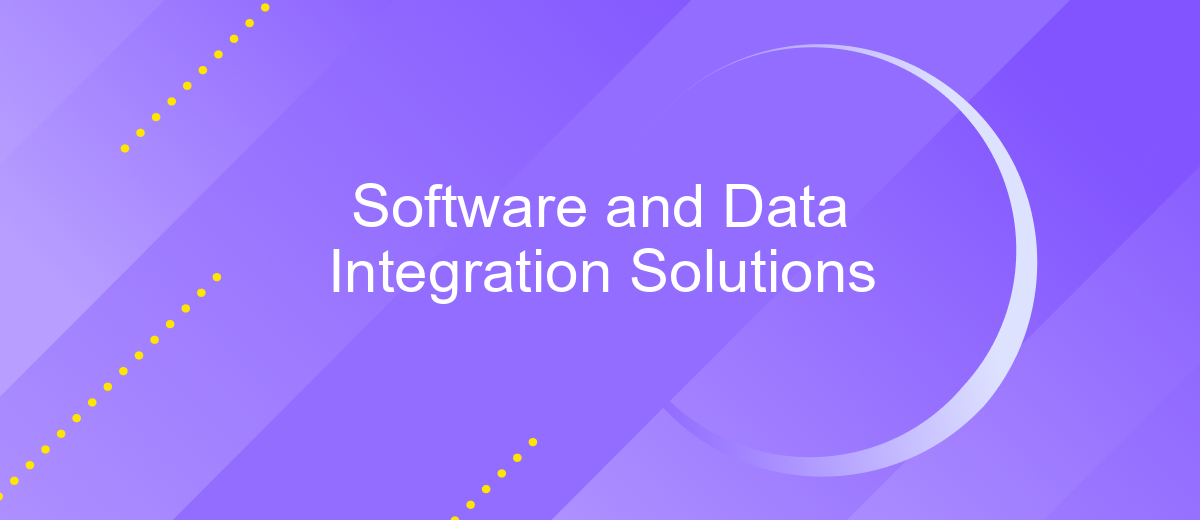Software and Data Integration Solutions
In today's rapidly evolving digital landscape, effective software and data integration solutions are critical for businesses seeking to enhance operational efficiency and drive innovation. These solutions enable seamless communication between disparate systems, ensuring that data flows smoothly across platforms. By leveraging advanced integration technologies, organizations can unlock valuable insights, streamline processes, and maintain a competitive edge in an increasingly data-driven world.
Understanding Software and Data Integration Challenges
In today's rapidly evolving technological landscape, integrating software and data systems poses significant challenges for businesses. Organizations often deal with disparate systems that need to communicate seamlessly to ensure efficient operations. The complexity increases as companies adopt new technologies, leading to compatibility issues and data silos. Moreover, ensuring data security and maintaining data integrity during integration processes are crucial concerns that require careful planning and execution.
- Legacy systems that are not designed for integration with modern platforms.
- Data format inconsistencies across different systems.
- Lack of standardized integration protocols.
- Scalability issues when handling large volumes of data.
- Ensuring data privacy and compliance with regulations.
Addressing these challenges requires a strategic approach that includes thorough analysis, selecting appropriate integration tools, and fostering collaboration between IT and business units. By understanding these obstacles, organizations can develop robust integration strategies that not only bridge technological gaps but also enhance overall business efficiency and innovation. Successfully overcoming these challenges can lead to improved decision-making, streamlined operations, and a competitive edge in the market.
Exploring Different Integration Solutions

In today's rapidly evolving digital landscape, businesses are increasingly reliant on seamless integration solutions to ensure their software and data systems work harmoniously. The integration of disparate systems can be a daunting task, but it is essential for optimizing operations and enhancing productivity. Various integration solutions are available, each offering unique capabilities tailored to specific business needs. These solutions range from traditional middleware to modern API-driven platforms, enabling businesses to connect applications, automate workflows, and streamline data exchange.
Among the plethora of integration tools, ApiX-Drive stands out as a versatile service that simplifies the integration process. It provides a user-friendly interface that allows businesses to connect various applications without the need for extensive coding knowledge. ApiX-Drive supports numerous integrations, facilitating real-time data synchronization and ensuring that information flows seamlessly across systems. By leveraging such tools, organizations can enhance their operational efficiency, reduce manual errors, and focus on their core business objectives. Exploring the right integration solution is crucial for businesses aiming to remain competitive in an increasingly interconnected world.
Key Considerations for Choosing the Right Solution

When selecting the ideal software and data integration solution, it's crucial to evaluate several key factors to ensure it aligns with your organization's needs and objectives. A comprehensive understanding of these considerations can significantly enhance the integration process and lead to more effective outcomes.
- Compatibility: Ensure the solution is compatible with your existing systems and can seamlessly integrate with the software and data sources you currently use.
- Scalability: Choose a solution that can grow with your business, accommodating increased data volumes and additional users without compromising performance.
- Security: Prioritize solutions with robust security features to protect sensitive data and comply with industry regulations.
- Usability: Opt for user-friendly platforms that require minimal training and offer intuitive interfaces to maximize productivity.
- Cost: Consider the total cost of ownership, including initial investment, ongoing maintenance, and potential future upgrades.
By carefully assessing these factors, organizations can identify a solution that not only meets their current requirements but also supports future growth and innovation. Thoughtful consideration of these elements will ensure a seamless integration process, leading to enhanced operational efficiency and strategic advantage.
Implementation and Best Practices

Implementing software and data integration solutions requires a strategic approach to ensure seamless connectivity and data flow between disparate systems. The first step involves thorough planning, which includes identifying integration requirements, selecting appropriate tools, and defining clear objectives. This phase is crucial for aligning the integration process with business goals and minimizing potential disruptions.
Once the plan is in place, the next phase is execution. This involves setting up the integration environment, configuring necessary software components, and establishing secure data connections. It's essential to monitor data flows and troubleshoot any issues promptly to maintain data integrity and system performance.
- Utilize middleware to facilitate communication between different systems.
- Implement data validation mechanisms to ensure data accuracy.
- Adopt scalable solutions to accommodate future growth and changes.
- Regularly update and maintain integration components to avoid obsolescence.
Finally, continuous evaluation and optimization are vital for sustaining integration efficiency. Regular feedback loops and performance reviews help identify areas for improvement, ensuring that the integration solution evolves with the organization's needs. By adhering to these best practices, businesses can achieve a robust and flexible integration framework that supports their operational objectives.
Future Trends in Software and Data Integration
As the landscape of software and data integration continues to evolve, several key trends are emerging that promise to reshape the industry. One major trend is the increasing adoption of artificial intelligence and machine learning to enhance integration processes. These technologies enable more efficient data handling, predictive analytics, and automated decision-making, allowing businesses to streamline operations and gain deeper insights. Additionally, the rise of low-code and no-code platforms is democratizing integration capabilities, empowering non-technical users to create sophisticated workflows without extensive coding knowledge.
Another significant trend is the growing emphasis on real-time data integration, driven by the demand for immediate insights and agile business responses. This is facilitated by cloud-based solutions and APIs that enable seamless connectivity between disparate systems. Services like ApiX-Drive are at the forefront, offering user-friendly interfaces to set up integrations quickly and efficiently. Furthermore, the focus on data security and privacy is intensifying, with companies prioritizing secure data transfers and compliance with regulations. As these trends converge, they are paving the way for more integrated, responsive, and secure digital ecosystems.
FAQ
What is software and data integration?
Why is data integration important for businesses?
What challenges are commonly faced during software integration?
How can businesses automate data integration processes?
What should be considered when choosing a data integration solution?
Time is the most valuable resource in today's business realities. By eliminating the routine from work processes, you will get more opportunities to implement the most daring plans and ideas. Choose – you can continue to waste time, money and nerves on inefficient solutions, or you can use ApiX-Drive, automating work processes and achieving results with minimal investment of money, effort and human resources.

